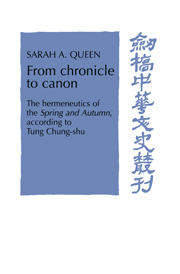Book contents
- Frontmatter
- Contents
- List of tables
- Acknowledgments
- List of abbreviations
- 1 Introduction
- PART I Three perspectives on the authenticity of the Ch'un-ch'iu fan-lu
- PART II Exegesis and canonization
- 5 The Spring and Autumn and Kung-yang tradition
- 6 Reforming the Ch'in laws
- 7 The wider circle of Han jurisprudence
- 8 Refashioning the imperial rites
- 9 Canon, cosmos, and court patronage
- 10 Conclusion
- Appendix 1 The birth and death dates of Tung Chung-shu
- Appendix 2 The dates of the Han-shu 56 memorials
- Appendix 3 Han transmission of Kung-yang learning
- Appendix 4 Han dynasty disciples of Tung Chung-shu
- Appendix 5 Citations and titles attributed to Tung Chung-shu
- Appendix 6 Transmission of Ch'un-ch'iu fan-lu editions
- Selected bibliography
- Index
7 - The wider circle of Han jurisprudence
Published online by Cambridge University Press: 10 December 2009
- Frontmatter
- Contents
- List of tables
- Acknowledgments
- List of abbreviations
- 1 Introduction
- PART I Three perspectives on the authenticity of the Ch'un-ch'iu fan-lu
- PART II Exegesis and canonization
- 5 The Spring and Autumn and Kung-yang tradition
- 6 Reforming the Ch'in laws
- 7 The wider circle of Han jurisprudence
- 8 Refashioning the imperial rites
- 9 Canon, cosmos, and court patronage
- 10 Conclusion
- Appendix 1 The birth and death dates of Tung Chung-shu
- Appendix 2 The dates of the Han-shu 56 memorials
- Appendix 3 Han transmission of Kung-yang learning
- Appendix 4 Han dynasty disciples of Tung Chung-shu
- Appendix 5 Citations and titles attributed to Tung Chung-shu
- Appendix 6 Transmission of Ch'un-ch'iu fan-lu editions
- Selected bibliography
- Index
Summary
The interpretations described in the preceding chapter, which were shaped by the confluence of the Kung-yang tradition and the concerns of Han dynasty Kung-yang scholars to critique and reform the Ch'in legacy, delineated numerous principles and precedents. How influential were these views? When Han administrators settled cases, they often cited precedents and principles from the Kung-yang tradition. In fact, they drew from the Kung-yang reading of the Spring and Autumn far more than the Tso or Ku-liang, the two other principal commentaries on the Spring and Autumn that animated legal discussions of the day. Moreover, in both exegetical topoi and analytical mode, their interpretations were often identical to those of Tung Chung-shu. These similarities suggest that scholars like Tung Chung-shu, who followed and developed the Kung-yang Commentary to the Spring and Autumn, influenced Han legal proceedings in important ways. This chapter illustrates the ways in which official administrators applied principles and precedents from the Kung-yang Commentary to settle legal cases of the period.
Motive
In the previous chapter we saw that Kung-yang exegetes frequently argued that when determining his judgments, Confucius considered the intent of the accused to be one of the most important factors. As the following two examples illustrate, Han officials also employed this righteous principle to resolve legal cases. The first case, which occurred when Emperor Ai came to the throne in 7 b.c.e., involved several members of the central court.
- Type
- Chapter
- Information
- From Chronicle to CanonThe Hermeneutics of the Spring and Autumn according to Tung Chung-shu, pp. 163 - 181Publisher: Cambridge University PressPrint publication year: 1996



